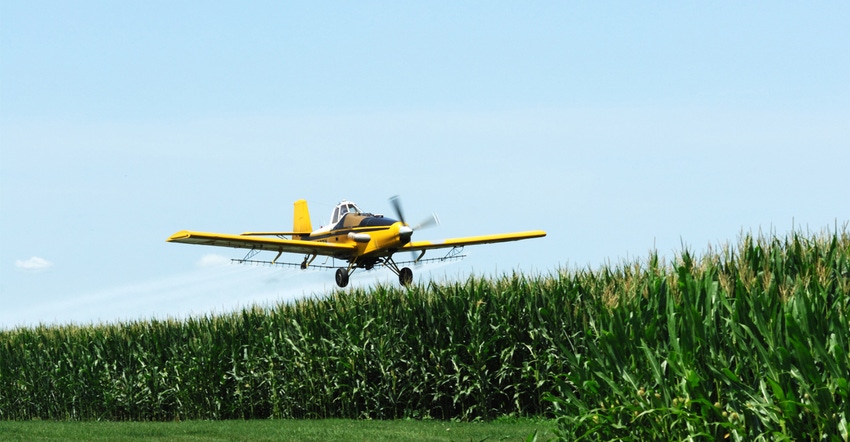May 19, 2021

Flying acrobatic planes delivering fungicide applications to Iowa cornfields has become a normal sight across the state in July and August. These planes are increasing in numbers, as farmers have seen a rise in foliar disease pressure on corn, and are recognizing the health benefits to corn plants.
However, with as much fungicide that is applied “just because,” it is important for farmers to realize that this application should not be an automatic decision for all fields in every season.
Targeting fields that are more likely to have disease incidents, such as fields with a disease history, those planted with a susceptible hybrid, and fields where topography leads to increased morning dew or fogs, will help limit the resistance to fungicide chemistries from developing.
Scouting fields and keeping up to date with diseases occurring in your area is still the best method for determining when fungicides should be applied to corn. But once the determination to apply a fungicide has been made, the timing of that application can make or break your opportunities for economic gain with fungicides.
Optimum timing
Timing of fungicide applications is one of the questions farmers have, with the debate being: Should a treatment be made when a disease is present, or should the fungicide be applied as a preventive measure early in the season?
Corn is most vulnerable to yield loss from tasseling through the early grain-fill period of the growing season due to diseases. As the plants approach physiological maturity, they are less susceptible to yield loss due to foliar disease. Therefore, fungicide applications have typically occurred within this window of growth and maturity to maximize protection.
During the growing season, corn may be affected by one or more foliar diseases, such as gray leaf spot, northern corn leaf blight or others. Knowing the timeline of disease infection can help you determine an application window given your disease history or the environmental conditions present.
As an example, gray leaf spot starts in the lower canopy, and some research at Iowa State University has shown that an earlier V12 application could help reduce this disease. This could be due to the ability to get fungicides down to those lower leaves in the canopy at V12 in association with the right environmental conditions.
Other diseases, like southern rust, are late-season diseases in which an earlier-application time frame would not have value. Generally, a fungicide applied when southern rust has been found in the field and the corn growth stage is between R1 and R3 will provide the best protection for corn yield potential with this disease.
Depending on the foliar disease, the hybrid planted and environmental conditions, a fungicide application at tasseling (VT) and up to silking (R1) has been shown by many university studies to have the greatest potential economic benefit due to increased yields.
Earlier applications
However, what if a farmer applied earlier in the season, such as V6, or made an in-furrow application for season-long control? A study published on March 17 titled Impact of foliar fungicide timing and fungicide class on corn yield response in the United States and Ontario, Canada evaluated more than 400 data points from trials across the U.S. and Ontario to compare foliar fungicides applied at V6; tasseling (VT); and a two-pass program, where fungicide was applied at V6 and VT. The study found application timing significantly affected yield response, with more than 68% of the 436 comparisons resulting in a positive yield response. VT (tasseling), and V6 and VT applications of certain fungicide class combinations, resulted in nearly three times a greater yield response than the V6 timing alone. These data are consistent with many other studies published and reinforce the application time frame of VT through R1 over V6. The study also showed that a farmer's probability of recovering fungicide program costs improves with later timing (VT) and multiple fungicide classes.
In-furrow application
In-furrow fungicide application timing is the newer player in the game for disease control. Research has been conducted at many universities, and some positive results have been found. More research and time will tell if this method will be as beneficial, both economically and control-wise, for certain diseases. However, it is a practice that farmers can research themselves if interested.
Many decisions must work in concert for a farmer to get a clear picture of when to apply a fungicide to a cornfield to gain maximum efficiencies and potential profitability. Understanding that fungicides will only be effective at controlling disease and profitable if all sides the disease triangle are present (pathogen, host and favorable environmental conditions). A field must be scouted to determine the presence of a disease and its severity level, and then the correct fungicide and timing chosen to control the disease. Fungicides are a valuable tool in a farmer’s toolkit to help protect corn from yield loss; they should be used wisely and in a timely manner in order to have them available for many years to come.
Witt is a field agronomist with Iowa State University Extension.
About the Author(s)
You May Also Like






